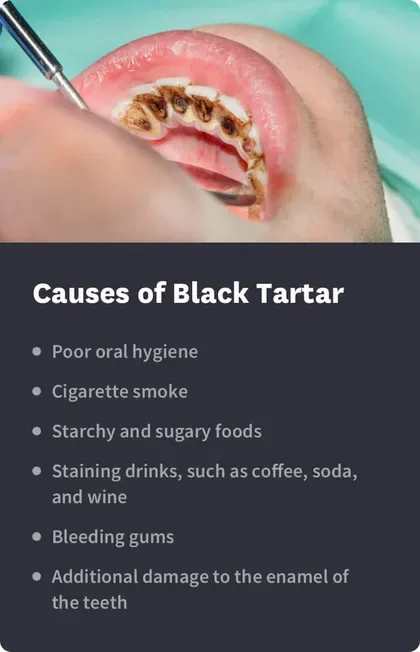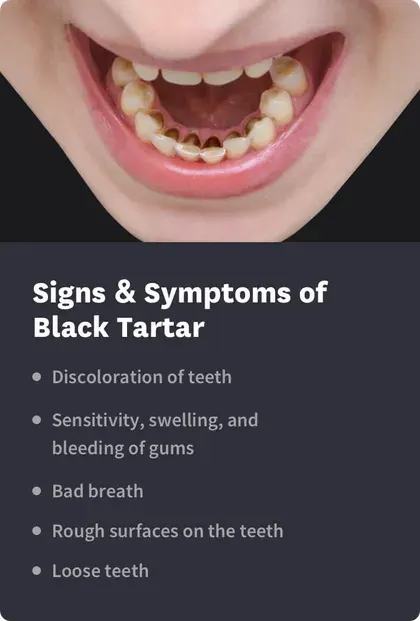Black Tartar: Causes, Symptoms & Treatment Options

Table of Contents
- What Is Black Tartar?
- Causes
- Symptoms
- Progression
- Treatment
- Ongoing Care
- Prevention & Management Tips
- References
Tartar typically starts out white or yellow, but it can become stained and appear black. Tartar that forms under the gum line is also called black tartar.
Black tartar can cause staining on the teeth, gum issues, and bad breath. Without treatment, black tartar can cause cavities and lead to gum disease.
Black tartar needs to be initially treated by a dentist, as it is impossible to remove without a professional cleaning.
What is Black Tartar?
When you eat or drink, particularly things that are sugary or starchy, bacteria can form on your teeth. When bacteria builds up, it forms plaque.
As plaque builds up and hardens into tartar on your teeth, it will usually look yellow. If not treated, plaque can harden and become tartar, or calculus.
The longer the tartar stays on your teeth, the more likely it is to become discolored and potentially turn black.
Tartar can also build up under your gum line, and this is black tartar.
The longer the tartar stays on your teeth, the more likely it is to become discolored and potentially turn black. Tartar can also build up under your gum line, and this is black tartar.
Causes

Generally, the most common cause for black tartar is poor oral hygiene — a lack of proper tooth brushing and flossing.
Black tartar that forms under the gum line is also called subgingival tartar. It disrupts the blood vessels in your gums. The mixing of the proteins and pigmentation in your blood with tartar cause it to turn black.
Cigarette smoke
Starchy and sugary foods
Staining drinks, such as coffee, soda, and wine
Bleeding gums
Additional damage to the enamel of the teeth
Black Tartar Symptoms

These are signs of black tartar:
Discoloration of the teeth
Sensitivity, swelling, and bleeding of the gums
Bad breath
Rough surfaces on the teeth
Loose teeth
If you notice any of these symptoms, it is important to contact your dentist right away.
Progression of Black Tartar
Left untreated, black tartar under the gum line can progress into gum disease. The risk of gingivitis and periodontitis are both raised by the presence of plaque and tartar.
Gum disease also increases the risk for chronic health conditions. It can even cause your gum tissue to loosen and your teeth to fall out if not treated properly.
Continuing to eat and drink foods that cause additional plaque and tartar buildup, and that can stain the teeth, can make black tartar worse. Smoking and using tobacco products and certain medications can also cause it to worsen.
Pregnancy and hormonal changes can impact the progression of plaque and tartar buildup as well as the progression of gum disease.
How Black Tartar Is Treated
Black tartar needs to be treated and removed by a dental professional. A dentist will examine the level of black tartar present and then use a variety of tools to remove the buildup.
Manual scrapers and ultrasonic tools can be used to break up the hardened material. A professional comprehensive dental cleaning can help to further remove the tartar.
When black tartar is on your teeth and under your gum line, a procedure called scaling and root planing is often needed to remove it. This is a two-part procedure that will initially use a scaler to remove the tartar from under your gum line and off your teeth. This looks like a hook and is generally stainless steel. It can reach up underneath your gums to scrape the tartar off your teeth in those hard-to-reach places.
Ongoing Care and Prevention Methods
To keep black tartar from returning, you will need to keep up with your routine dental cleanings at least twice per year.
If you are particularly prone to plaque and tartar buildup, you may need to see your dentist for a cleaning more frequently. Good oral hygiene is key to keeping black tartar at bay.
After black tartar has been removed by a dentist or dental hygienist, it is up to you to keep it from coming back. Prevention is the best way to manage black tartar after the initial professional cleaning to remove it. Prevention methods focus on oral hygiene and healthy habits as well as paying attention to any changes in your teeth, mouth, or gums.
Tips for Preventing & Managing Black Tartar Long Term
Here are some tips for ongoing care and prevention of black tartar:
Brush your teeth after meals. Aim to brush at least two times, for two minutes, every day.
Consider an electric toothbrush, as these can often break down plaque more effectively.
Use a fluoride or tartar-prevention toothpaste.
Floss every day.
Use a water flosser, specialized brush, or plastic or wooden pick, as recommended by your dental professional.
Rinse your mouth with a fluoride mouthwash daily.
Stay away from tobacco products.
Limit your intake of refined and processed foods, sticky foods, and sugary drinks.
Drink plenty of water.
Have your teeth professionally cleaned at least once every six months.
If you start noticing plaque buildup on your teeth or feel like something is off, contact your dentist right away. Treating early plaque buildup can help to prevent black tartar.
Black tartar can usually be treated and removed completely with the help of a dental professional. You can keep it from coming back by taking care of your mouth and teeth.
